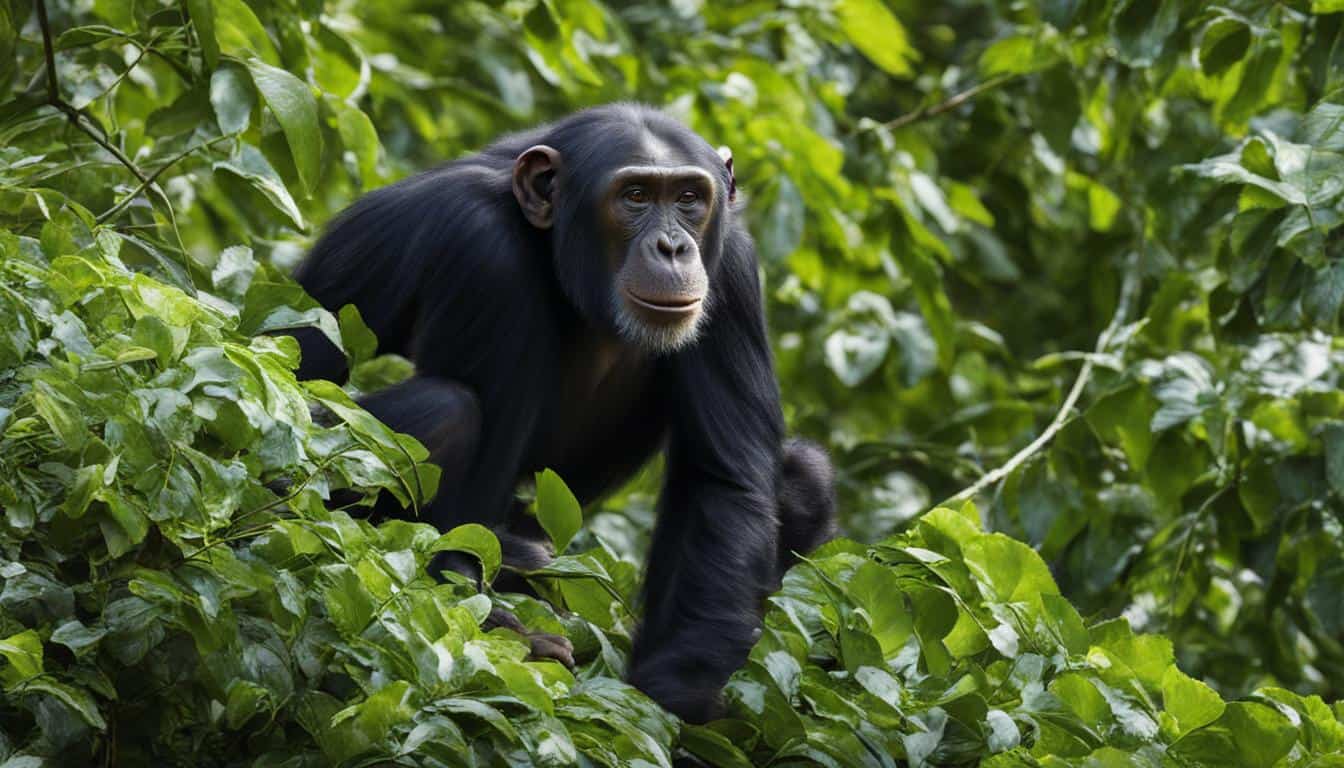Welcome to our article on the impact of chimpanzee tourism and its role in conservation efforts. Chimpanzee tourism, which involves observing these fascinating primates in their natural habitats, can have both positive and negative effects on chimpanzee populations and the broader conservation landscape. It is vital to understand these impacts to promote sustainable chimpanzee tourism practices and ensure the long-term well-being of these incredible creatures.
Chimpanzee populations are facing numerous challenges, with habitat loss and human activities being significant contributors to their decline. Gombe National Park in Tanzania, for example, has experienced a concerning decrease in its chimpanzee population due to habitat destruction caused by deforestation and human settlements. Additionally, the increase in human population surrounding these habitats raises the risk of human-to-animal disease transmission, posing a threat to the health and survival of the chimpanzees.
Addressing the challenges of coexistence and conservation is crucial to protect both chimpanzee populations and the well-being of local communities. Efforts are being made to strike a balance between tourism and conservation by implementing measures such as limiting the number of daily tourists observing chimpanzees, engaging in community development projects to meet local needs, conducting conservation outreach and education programs, and maintaining scientific research efforts.
To reduce the risk of disease transmission between humans and chimpanzees, various preventive measures need to be taken by tourists and conservation employees alike. These include health education programs, facilitating proper hand hygiene and vaccination awareness, and implementing employee health programs within protected areas.
Sustainable livelihood practices play a significant role in chimpanzee conservation. By providing local communities with sustainable livelihood options, such as family planning support and environmentally conscious agricultural practices, we can reduce the pressure on chimpanzee habitats and foster harmonious coexistence between humans and chimpanzees.
Global cooperation is indispensable for effective great ape conservation. Initiatives like the Great Ape Survival Project (GRASP) bring together representatives from countries with great ape populations and international organizations. However, further concerted efforts are needed to develop a comprehensive global survival strategy that addresses the threats faced by great apes and integrates conservation initiatives at both global and local levels.
As responsible tourists, it is essential to prioritize primate welfare and contribute to conservation efforts. By practicing responsible primate tourism, supporting wildlife centers and sanctuaries, and adhering to guidelines and regulations, we can ensure the long-term survival of chimpanzees and promote their conservation for future generations.
The Decline of Chimpanzee Populations in Gombe National Park
Gombe National Park, located in Tanzania, has witnessed a significant decline in its chimpanzee population over the past few decades. This decline has been attributed to various factors, including habitat destruction and human-to-animal disease transmission.
The destruction of chimpanzee habitats due to human activities, such as deforestation for agriculture and settlements, has had a detrimental impact on the chimpanzee population in Gombe National Park. As forests are cleared to make way for agriculture and human settlements expand, the available habitat for chimpanzees shrinks, leading to a decline in their numbers.
Furthermore, the increase in the human population in the areas surrounding Gombe National Park has heightened the risk of disease transmission between humans and chimpanzees. As humans encroach upon chimpanzee habitats, the likelihood of transmission of diseases from humans to chimpanzees increases. These diseases can have devastating effects on the health and survival of chimpanzees, further contributing to the decline in their populations.
Addressing the Challenges of Coexistence and Conservation
Efforts are being made to address the challenges of human-wildlife coexistence and promote conservation in chimpanzee habitats. To ensure the long-term survival of chimpanzees and protect the livelihoods of local communities, various initiatives are being implemented.
Limiting tourist activities: One of the key approaches is to limit the number of tourists allowed to observe chimpanzees each day. By reducing the overall impact of tourism on chimpanzee populations, it becomes possible to minimize disturbance and ensure their well-being.
Community development projects: Another important aspect is the implementation of community development projects. These projects aim to address the health and livelihood needs of local communities living near chimpanzee habitats. By providing basic amenities, healthcare facilities, and educational opportunities, these projects foster sustainable development and help create a positive relationship between communities and wildlife.
Conservation outreach and education programs: To raise awareness about the importance of chimpanzee conservation, outreach and education programs are being conducted. These programs educate local communities, tourists, and stakeholders about the significance of preserving chimpanzee habitats and the benefits of coexisting with these incredible creatures.
Scientific research: Ongoing scientific research plays a vital role in understanding the behavior, ecology, and conservation needs of chimpanzees. By conducting comprehensive studies, researchers can gather valuable data and insights that inform effective conservation strategies and management plans for chimpanzee habitats.
All these initiatives combine efforts and expertise from various stakeholders, including researchers, conservation organizations, local communities, and government bodies. By working together, it is possible to find sustainable solutions that promote human-wildlife coexistence and conserve chimpanzee populations for future generations.
Reducing the Risk of Disease Transmission
To ensure the health and safety of both humans and chimpanzees, it is important to implement preventive measures that reduce the risk of zoonotic disease transmission. Tourists play a crucial role in minimizing the spread of diseases by following responsible behavior and adhering to recommended guidelines.
Tourist behavior:
- Follow instructions from park rangers and guides regarding appropriate behavior around chimpanzees.
- Keep a safe distance from the chimpanzees to avoid direct contact.
- Refrain from feeding or touching the chimpanzees, as this can increase the risk of disease transmission.
Health education:
- Provide tourists with comprehensive health education about zoonotic diseases and preventive measures.
- Emphasize the importance of vaccinations, such as tetanus and hepatitis A, to protect against potential diseases.
- Promote proper hand hygiene, including frequent handwashing with soap and water or using hand sanitizers.
Preventive measures:
- Encourage the use of facemasks during chimpanzee sightings to reduce the risk of droplet transmission.
- Limit the number of visitors allowed in protected areas to minimize overcrowding and enhance social distancing.
- Implement health screenings for tourists before entering protected areas to identify potential health risks.
Employee health programs:
- Establish employee health programs that provide proper preventive steps and clinical services to protected area conservation employees.
- Ensure regular health check-ups for employees to detect and prevent potential diseases.
Health education for local communities:
- Develop health education programs targeted at local communities to raise awareness about zoonotic disease transmission.
- Provide information on preventive measures, such as vaccinations, proper hygiene practices, and the importance of early disease detection.
- Collaborate with local health authorities to facilitate access to healthcare services and screenings for communities living near chimpanzee habitats.

| Methods | Benefits |
|---|---|
| Tourist behavior | Reduces the risk of direct contact and disease transmission between humans and chimpanzees. |
| Health education | Empowers tourists with knowledge and preventive measures to protect themselves and chimpanzees from zoonotic diseases. |
| Preventive measures | Minimizes the spread of diseases through the use of facemasks, social distancing, and visitor restrictions. |
| Employee health programs | Safeguards the health and well-being of protected area conservation employees, reducing the risk of disease transmission to chimpanzees. |
| Health education for local communities | Raises awareness, promotes responsible behavior, and fosters a culture of disease prevention within local communities. |
The Role of Sustainable Livelihood Practices in Conservation
Initiatives focused on providing sustainable livelihoods for communities living near chimpanzee habitats play a crucial role in conservation efforts. By addressing the needs of local communities and promoting conservation awareness, these initiatives aim to reduce the pressure on chimpanzee habitats and promote sustainable coexistence between humans and chimpanzees.
- Family Planning: Projects that provide family planning information and support empower local communities to make informed decisions about their reproductive health. By ensuring access to contraception and reproductive health services, communities can better manage their population growth and reduce the strain on limited resources, resulting in a healthier environment for both humans and chimpanzees.
- Environmental Practices: Promoting environmentally sustainable agricultural practices is essential to minimize the negative impact of human activities on chimpanzee habitats. Training programs that encourage organic farming, agroforestry, and responsible land management help preserve biodiversity, conserve soil fertility, and reduce the use of harmful chemicals, benefiting both humans and chimpanzees.
- Access to Basic Services: Improving access to basic services such as water and sanitation not only enhances the quality of life for local communities but also reduces their reliance on the natural resources within the chimpanzee habitats. By providing clean water sources and adequate sanitation facilities, these initiatives minimize the need for communities to encroach further into the chimpanzee’s habitat, ensuring their long-term survival.
By integrating sustainable livelihood practices that encompass family planning, environmental practices, and access to basic services, conservation efforts can address the needs of both humans and chimpanzees. These initiatives promote harmony between communities and their natural surroundings, ultimately contributing to the preservation of chimpanzee populations and their habitats.
Global Cooperation for Great Ape Conservation
The conservation of great apes, including chimpanzees, is a global effort that requires international cooperation and coordinated strategies. One prominent initiative in this field is the Great Ape Survival Project (GRASP), which brings together representatives from countries with great ape populations, along with international organizations, to develop and implement conservation strategies.
GRASP aims to address the pressing challenges faced by great apes and integrate conservation efforts at both the global and local levels. By fostering collaboration and knowledge-sharing, GRASP seeks to protect these remarkable creatures and their habitats.
However, there is an urgent need for a comprehensive global survival strategy that encompasses all great ape species and acknowledges the interconnectedness of their habitats. Such a strategy should consider the various threats to great apes, including habitat loss, illegal wildlife trade, and human-wildlife conflicts.
Effective conservation strategies should not only focus on protecting great apes within their natural environments but also address the root causes of their vulnerability. This includes promoting sustainable livelihood practices for local communities, raising conservation awareness, and implementing measures to mitigate human-wildlife conflicts.
By promoting international cooperation and sharing best practices, we can ensure the long-term survival of great apes and their invaluable contributions to our planet’s biodiversity.
Responsible Primate Tourism for Conservation
As a tourist, it is essential to be responsible and make choices that benefit both local communities and primate conservation. One way to contribute to these efforts is by supporting wildlife centers and sanctuaries that prioritize primate welfare and conservation initiatives. These facilities work tirelessly to rescue, rehabilitate, and protect primates, providing them with a safe and natural environment where they can thrive.
When visiting areas with wild primates, it is crucial to adhere to guidelines and regulations set by local authorities. Maintaining a safe distance from the primates is important to respect their space and avoid causing them stress or harm. Additionally, it is vital to avoid behaviors that may put the primates at risk, such as feeding them or attempting to touch them.
By practicing responsible primate tourism, you can play a vital role in protecting these incredible animals. Your support contributes to the funding and resources needed for conservation initiatives, such as habitat preservation, research projects, and community education. Remember, the long-term survival of primates depends on our collective efforts to promote responsible tourism, primate welfare, and the conservation of their natural habitats.
What are the potential negative impacts of chimpanzee tourism on conservation efforts?
Chimpanzee tourism can have negative impacts on successful chimpanzee conservation cases. Increased human interaction can disrupt their natural behaviors, lead to disease transmission, and habitat destruction. Over-commercialization and unregulated tourism can also exploit and harm the very animals conservation efforts aim to protect.
What are the similarities and differences in the impact of tourism on chimpanzee and gorilla populations and conservation efforts?
Gorilla tourism impact on conservation can have both negative and positive effects on chimpanzee and gorilla populations. Both species face threats from habitat destruction and disease spread by tourists. However, tourism also raises awareness and funds for conservation efforts, benefiting both populations in some cases.







